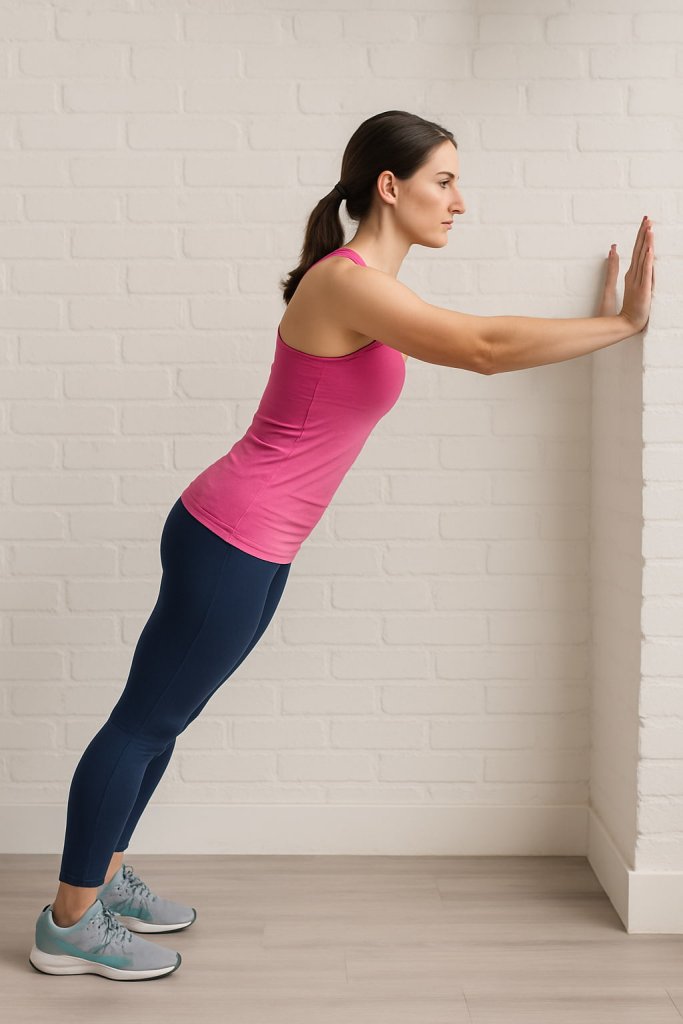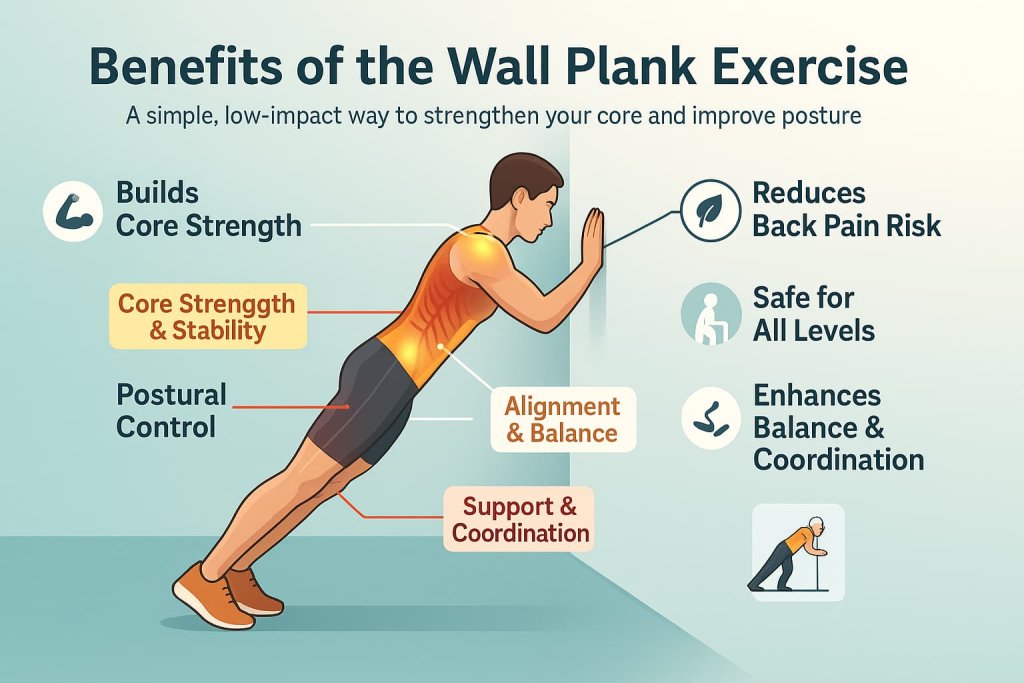The wall plank exercise is a beginner-friendly core workout that builds strength, balance, and posture without requiring you to get on the floor.
Unlike traditional planks, the wall plank uses a standing or inclined position—making it ideal for beginners, seniors, or anyone with wrist, knee, or back discomfort. This simple isometric move activates your abs, glutes, shoulders, and back to improve stability and spinal alignment.

Understanding how to do a wall plank correctly can help you improve posture, protect your lower back, and increase functional strength for daily activities.
What Is a Wall Plank?
The wall plank is a modified version of the standard plank performed against a wall rather than the floor. You lean your body at an angle while maintaining a straight line from head to heels, engaging your entire core to resist gravity.

This variation reduces load on your shoulders, wrists, and lower back while still challenging your abdominal and postural muscles. It’s often used in physiotherapy, senior fitness, and beginner core training programs.
How to Do a Wall Plank Exercise
Step-by-Step Guide:
- Position: Stand facing a wall about 2–3 feet away.
- Setup: Place your forearms or palms on the wall at shoulder height and width.
- Alignment: Walk your feet back slightly until your body forms a straight line from head to heels.
- Engage Core: Tighten your abs and glutes, keeping your neck neutral and gaze slightly downward.
- Hold: Maintain tension for 20–45 seconds, breathing steadily.
- Rest & Repeat: Perform 2–3 sets, gradually increasing duration as your strength improves.
Trainer Tip:
Press gently into the wall with your forearms to activate your shoulders and chest, and avoid arching your lower back.
Benefits of the Wall Plank Exercise
1. Builds Core Strength
Wall planks activate the rectus abdominis, transverse abdominis, obliques, and erector spinae, helping stabilize your spine and pelvis; a 2025 systematic review in Frontiers in Sports & Active Living reported that core training (including plank-type isometrics) improves core endurance and trunk stability measures in athletes (full text).
2. Improves Posture
By reinforcing spinal alignment and shoulder stability, wall planks help reduce forward rounding and slouching. The wall provides feedback so you can keep your hips, ribs, and shoulders aligned.

3. Reduces Back Pain Risk
A 2022 open-access systematic review found that core stabilization exercises significantly reduce pain and improve function in non-specific low back pain, supporting deep-core strengthening for lumbar support (PMC article).
4. Safe for All Levels
Because you control the angle and pressure against the wall, the exercise is accessible to seniors, beginners, or individuals recovering from injury.
5. Enhances Balance and Coordination
Maintaining the plank position requires controlled engagement of multiple muscle groups, supporting better balance and overall body awareness.
Muscles Worked in the Wall Plank
| Primary Muscles | Supporting Muscles |
|---|---|
| Rectus Abdominis | Obliques |
| Transverse Abdominis | Erector Spinae |
| Gluteus Maximus | Shoulders (Deltoids) |
| Quadriceps | Triceps & Serratus Anterior |
These muscles work together to stabilize your trunk, keep your spine neutral, and maintain proper alignment throughout the movement.
Variations of the Wall Plank
1. Forearm Wall Plank
Why it works:
This variation reduces wrist strain while increasing activation in the core and shoulders. It’s excellent for improving postural control and endurance without stressing the joints.
Muscles worked:
- Rectus abdominis
- Transverse abdominis
- Shoulders (anterior deltoids)
- Glutes and spinal stabilizers
How to do it:
- Stand facing a wall and place your forearms flat against it at shoulder height.
- Step your feet back 2–3 feet until your body forms a straight line from head to heels.
- Engage your core, squeeze your glutes, and press gently into the wall.
- Hold for 20–45 seconds, breathing steadily.
Trainer Tip:
Focus on keeping your elbows directly below your shoulders and avoid arching your lower back — think “ribs down, core tight.”
2. Wall Plank with Leg Lift
Why it works:
Adding a leg lift introduces instability, forcing your core, glutes, and hips to work harder for balance and control. It also strengthens your posterior chain.
Muscles worked:
- Gluteus maximus and medius
- Hamstrings
- Core (rectus abdominis and obliques)
- Lower back stabilizers
How to do it:
- Assume a standard wall plank position with hands or forearms on the wall.
- Engage your core and lift one leg slowly 6–8 inches off the floor.
- Hold for 3–5 seconds, lower, then switch sides.
- Perform 8–10 reps per leg.
Trainer Tip:
Avoid shifting your hips or arching your back as you lift — keep your pelvis level and controlled.
3. Wall Plank Shoulder Tap
Why it works:
This dynamic version challenges anti-rotation strength, improving shoulder stability, balance, and deep core control.
Muscles worked:
- Obliques and transverse abdominis
- Deltoids and triceps
- Glutes and lower back
- Serratus anterior (for scapular control)
How to do it:
- Begin in a high wall plank with palms on the wall and body in a straight line.
- Tighten your core, then lift one hand to tap the opposite shoulder without twisting your hips.
- Alternate sides for 10–12 taps per set.
Trainer Tip:
Move slowly — the goal is stability, not speed. Imagine keeping a glass of water balanced on your lower back.
4. Inclined Wall Plank (Chair Support)
Why it works:
Using a chair or sturdy surface increases the angle and intensity slightly compared to a wall plank, preparing you for floor planks.
Muscles worked:
- Core and obliques
- Glutes and quads
- Shoulders and triceps
- Erector spinae
How to do it:
- Place your hands or forearms on a stable chair, bench, or countertop.
- Walk your feet back until your body forms a straight line from head to heels.
- Engage your abs and glutes, maintaining firm contact with the surface.
- Hold for 30–60 seconds, rest, and repeat 2–3 times.
Trainer Tip:
Keep your shoulders down and away from your ears. As you get stronger, lower the incline to make the exercise more challenging.
Common Mistakes to Avoid
- Arching your back: Keep your pelvis slightly tucked to avoid lumbar strain.
- Shrugging shoulders: Relax your traps and press your forearms gently into the wall.
- Holding your breath: Maintain steady breathing throughout.
- Standing too close: Step back far enough to feel resistance but not so far you lose balance.
Safety and Precautions
- Warm up before planking (marching, arm circles, gentle torso twists).
- Avoid this exercise if you have shoulder instability or acute back pain—consult a physical therapist first.
- Focus on maintaining alignment rather than holding longer durations.
- Stop immediately if you feel pain or dizziness.
FAQ
1. Is a wall plank as effective as a floor plank?
While wall planks are less intense, they still build core endurance, posture, and alignment—ideal for beginners or those easing into strength training.
2. How long should I hold a wall plank?
Start with 20–30 seconds, progressing to 45–60 seconds as your endurance improves.
3. Can seniors do wall planks safely?
Yes. Wall planks are low-impact and excellent for improving posture and stability in older adults.
4. Should I use my palms or forearms?
Both are effective. Use your forearms if you have wrist discomfort.
5. How often should I do wall planks?
Aim for 3–4 sessions per week, combining with light resistance and flexibility work.
6. Does wall planking burn fat?
It primarily strengthens the core. Pair it with full-body workouts and balanced nutrition for fat loss.
7. Can I do wall planks if I have back pain?
Consult a healthcare professional first, but many people find wall planks gentler on the back than floor planks.
Conclusion
The wall plank exercise is a simple, low-impact way to strengthen your core, improve posture, and enhance overall stability—without needing to get on the floor. Whether you’re a beginner, senior, or just seeking a safer alternative, this exercise offers an effective, accessible entry point to core training.
Start today — 2–3 sets a few times a week can make a real difference in your posture and strength.
Disclaimer:
This content is for informational purposes only and not medical advice. Always consult a healthcare or fitness professional before starting a new exercise program.
References
- Can wall squats and planks lower your blood pressure? (British Heart Foundation, 2023) — consumer-friendly explainer of the BJSM findings and safe practice.
- Trunk muscle activation in prone plank exercises with different body tilts (PubMed, 2024) — changing angle meaningfully modulates core activation; supports wall/incline progressions.
- Effects of different types of core training on pain and function in chronic non-specific LBP (Frontiers in Physiology, 2025) — comparative meta-analysis of core methods (stability/resistance/Pilates).
- Plank Performance and Pain in the Lower Back (J. Clin. Med., 2025) — longer plank holds don’t necessarily predict less LBP; emphasizes balanced endurance.
- Plank exercise improves respiratory capacity (Open Access, 2024) — 12-week plank program improved respiratory function and body composition markers.
